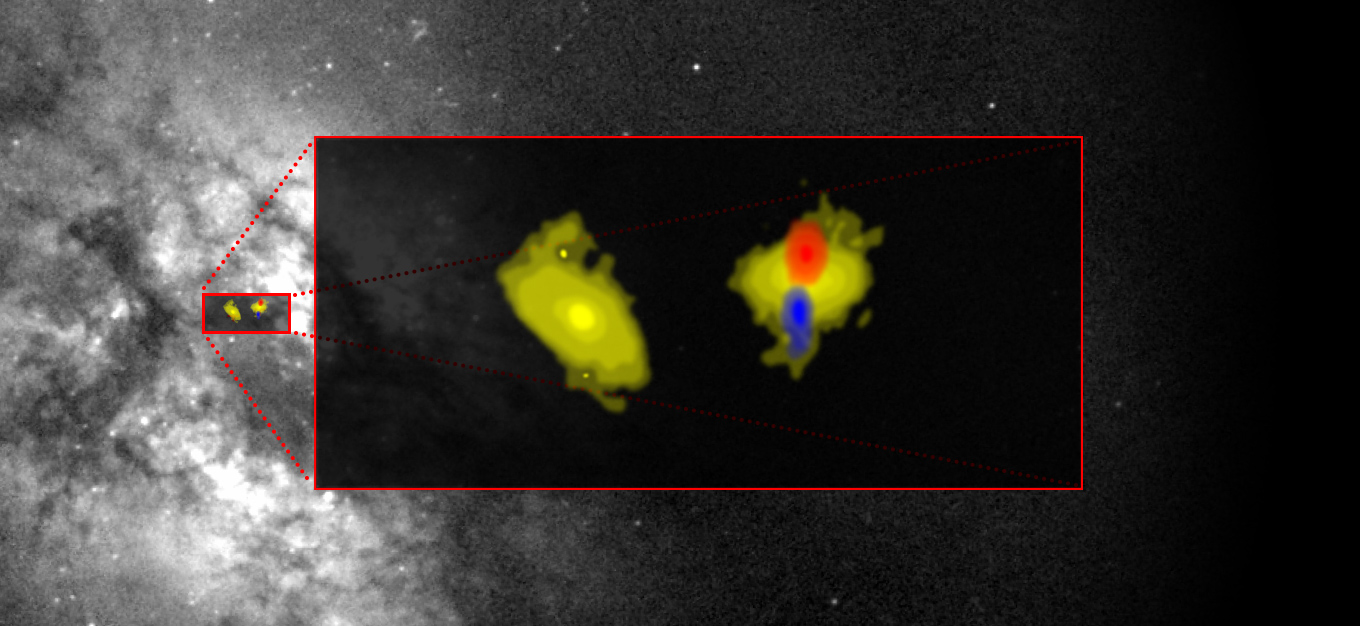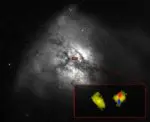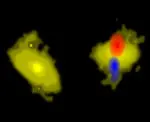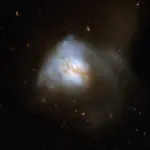ALMA Observes Outflow in Ultraluminous Infrared Galaxy
Astronomers using the Atacama Large Millimeter/submillimeter Array (ALMA) observed for the first time an outflow emerging from one of the nuclei in Arp 220, the closest Ultraluminous Infrared Galaxy to Earth resulting from the collision of two galaxies which are now in the process of merging. Although this object has been extensively studied, its compactness and obscuration have been a challenge for astronomers until now: ALMA observed the outflow from one of its nuclei in three dimensions (velocity and 2D spatial information). The results of this research appeared in the Astrophysical Journal Letters.
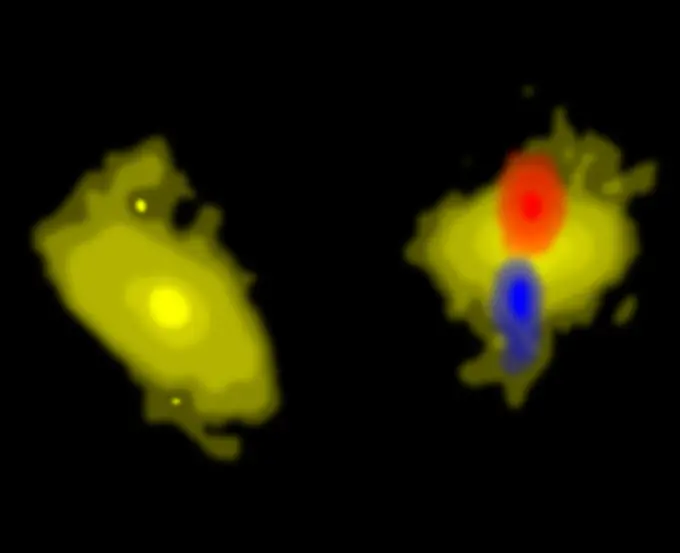
ALMA image of Arp 220 cores. The two cores (yellow), obscured by dust on visible wavelengths, observed by ALMA. The research team detected a bipolar outflow from the western nucleus and measured its velocity. In red, the North section of the outflow, particles are moving away from Earth. In blue, the South section of the outflow, particles are moving towards Earth. Credit: L. Barcos-Muñoz, N. Lira, J. Pinto - ALMA (NRAO/NAOJ/ESO)
The presence of an outflow has been previously detected in Arp 220. However, this is the first time it has been imaged and its kinematics and morphological characteristics determined. The flow is collimated, instead of the wide-angle morphology that is usually observed. With this discovery, it is possible now to start studying extragalactic outflows at 100 pc scales, giving the opportunity to research feedback processes in these deeply embedded galaxy nuclei.
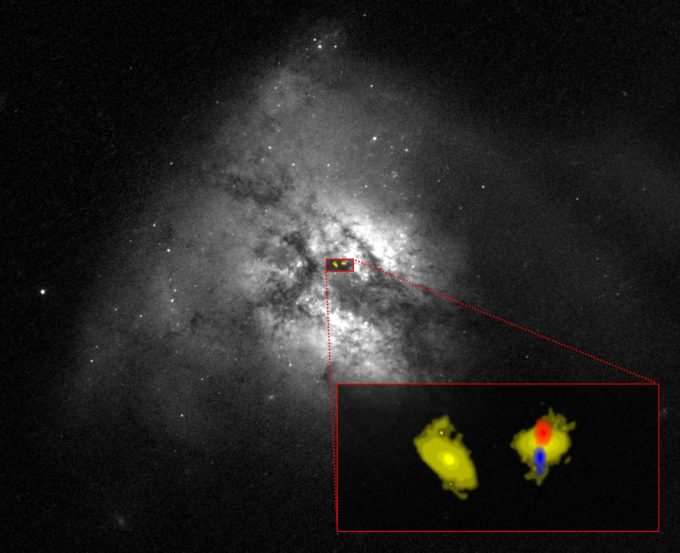
ALMA image of Arp 220 cores over HST image of Arp 220. The two cores (yellow), obscured by dust on visible wavelengths, are observed by ALMA. The research team detected a bipolar outflow from the western nucleus and measured its velocity. In red, the North section of the outflow, particles are moving away from Earth. In blue, the South section of the outflow, particles are moving towards Earth. Credit: L. Barcos-Muñoz, N. Lira, J. Pinto - ALMA (NRAO/NAOJ/ESO) / Hubble Space Telescope - (NASA/ESA)
"ALMA's observation wavelength, combined with its high sensitivity and resolution, allowed us to observe inside this very compact and dust obscured galaxy nucleus," explained Loreto Barcos-Muñoz, an NRAO Postdoctoral Fellow at ALMA observatory, and Principal Investigator of this research. "We confirmed the presence of an outflow and obtained a detailed image of its morphology and its velocity at the same time."
The new ALMA observations reveal a bipolar, fast, collimated outflow emerging from the western nucleus of Arp 220. The material transported from the core through the flows has a maximum speed of 840 km/s. According to Loreto Barcos-Muñoz, possible explanations for this outflow could be energy from supernovae and momentum transfers, radiation pressure feedback, and a central AGN.
Another finding that surprised the team of astronomers is that the outflow is brighter in HCN than in CO, while the opposite is the norm for most extragalactic outflows detected to date. Further observations are needed to determine the origin of this behavior, but this discovery challenges the current knowledge about extragalactic outflow gas properties.
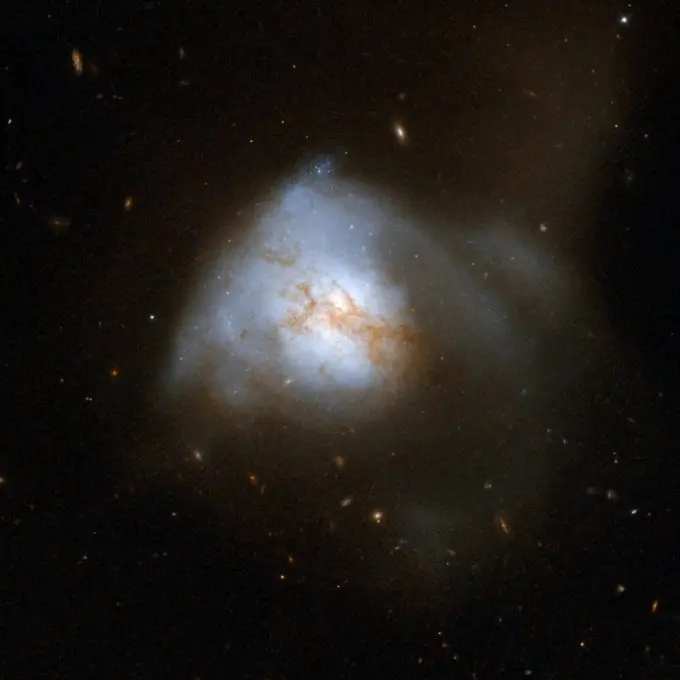
Arp 220 appears to be a single, odd-looking galaxy, but is in fact a nearby example of the aftermath of a collision between two spiral galaxies. It is the brightest of the three galactic mergers closest to Earth, about 250 million light-years away in the constellation of Serpens, the Serpent. The collision, which began about 700 million years ago, has sparked a cracking burst of star formation, resulting in about 200 huge star clusters in a packed, dusty region about 5,000 light-years across (about 5 percent of the Milky Way's diameter). The amount of gas in this tiny region equals the amount of gas in the entire Milky Way Galaxy. The star clusters are the bluish-white bright knots visible in the Hubble image. Arp 220 glows brightest in infrared light and is an ultraluminous infrared galaxy. Previous Hubble observations, taken in the infrared at a wavelength that looks through the dust, have uncovered the cores of the parent galaxies 1,200 light-years apart. Observations with NASA's Chandra X-ray Observatory have also revealed X-rays coming from both cores, indicating the presence of two supermassive black holes. Arp 220 is the 220th galaxy in Arp's Atlas of Peculiar Galaxies. Credit: NASA, ESA, the Hubble Heritage Team (STScI/AURA)-ESA/Hubble Collaboration and A. Evans (University of Virginia, Charlottesville/NRAO/Stony Brook University)
Additional Information
This research was published under the title "Fast, Collimated Outflow in the Western Nucleus of Arp 220" by Loreto Barcos-Muñoz et al. on the Astrophysical Journal Letters.
The research team was composed by Loreto Barcos-Muñoz [1,2], Susanne Aalto [3], Todd A. Thompson [4,5], Kazushi Sakamoto [6], Sergio Martín [1,7], Adam K. Leroy [4], George C. Privon [8,9], Aaron S. Evans [2,10], and Amanda Kepley [2].
The Atacama Large Millimeter/submillimeter Array (ALMA), an international astronomy facility, is a partnership of the European Organisation for Astronomical Research in the Southern Hemisphere (ESO), the U.S. National Science Foundation (NSF) and the National Institutes of Natural Sciences (NINS) of Japan in cooperation with the Republic of Chile. ALMA is funded by ESO on behalf of its Member States, by NSF in cooperation with the National Research Council of Canada (NRC) and the Ministry of Science and Technology (MOST) in Taiwan and by NINS in cooperation with the Academia Sinica (AS) in Taiwan and the Korea Astronomy and Space Science Institute (KASI).
ALMA construction and operations are led by ESO on behalf of its Member States; by the National Radio Astronomy Observatory (NRAO), managed by Associated Universities, Inc. (AUI), on behalf of North America; and by the National Astronomical Observatory of Japan (NAOJ) on behalf of East Asia. The Joint ALMA Observatory (JAO) provides the unified leadership and management of the construction, commissioning and operation of ALMA.
[1] Joint ALMA Observatory, Alonso de Córdova 3107, Vitacura, Santiago, Chile
[2] National Radio Astronomy Observatory, 520 Edgemont Road, Charlottesville, VA 22903, USA
[3] Department of Earth and Space Sciences, Chalmers University of Technology, Onsala Observatory, 439 94 Onsala, Sweden
[4] Astronomy Department, The Ohio State University, 140 W, 18th St, Columbus, OH 43210, USA
[5] Department of Astronomy and Center for Cosmology & Astro-Particle Physics, The Ohio State University, Columbus, OH 43210, USA
[6] Academia Sinica, Institute of Astronomy and Astrophysics, P.O. Box 23-141, Taipei 10617, Taiwan
[7] European Southern Observatory, Alonso de Córdova 3107, Vitacura, Casilla 763 0355, Santiago, Chile
[8] Instituto de Astrofísica, Facultad de Física, Pontificia Universidad Católica de Chile, Casilla 306, Santiago, Chile
[9] Department of Astronomy, University of Florida, 211 Bryant Space Sciences Center, Gainesville, FL 32607, USA
[10] Department of Astronomy, University of Virginia, 530 Mc-Cormick Road, Charlottesville, VA 22904, USA
Contacts
-
Nicolás Lira
Education and Public Outreach OfficerJoint ALMA Observatory, Santiago - ChilePhone: +56 2 2467 6519Cel: +56 9 9445 7726Email: [email protected] -
Loreto Barcos-Muñoz
Postdoctoral FellowJoint ALMA Observatory / NRAO, Santiago - ChileEmail: [email protected]
